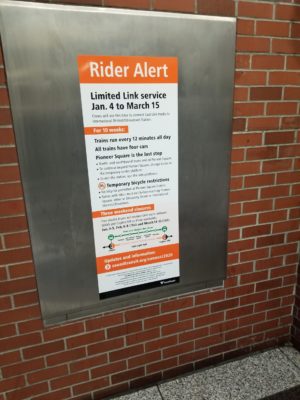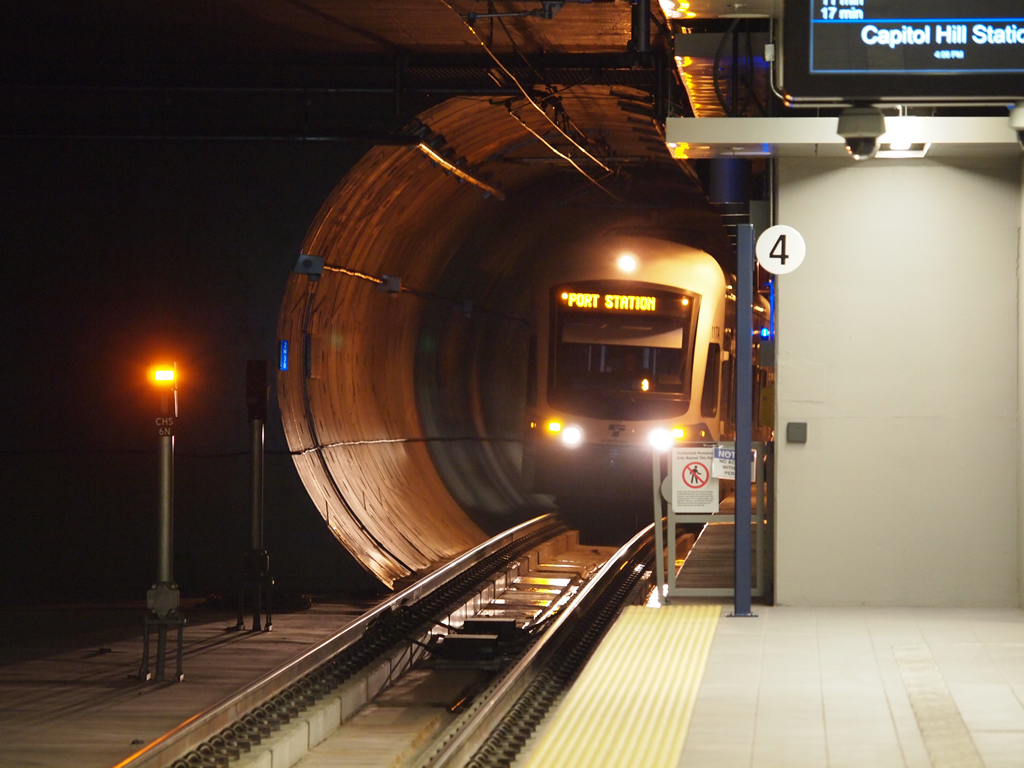Happy New Year, Cascadia Advocate readers!
Since it is now 2020, we can officially say that Sound Transit’s Northgate Link extention will be opening next year, which is very exciting news.
To prepare for Northgate Link and East Link, the first Link extension openings since 2016, there will be reduced Link service from the weekend of January 4th-5th until the weekend of March 14th-15th. There are a few important things to know about this project, dubbed Connect 2020 by the agency.
This construction initiative will connect the new East Link tracks intended to carry trains to and from Judkins Park station and the Eastside with the existing mainline tracks that run from Angle Lake in SeaTac to the University of Washington.
Even though East Link won’t be open for service until 2023, the tracks are largely complete between the Eastside and downtown Seattle and the project is ready for this next step. Sound Transit wishes to get the disruption the project will cause over with before Northgate Link opens in 2021. Since ridership tends to be lowest in the winter, now is the right time to proceed with Connect 2020.
To create the new connection to the mainline, Sound Transit must limit service to a single track during each phase of construction through downtown Seattle.
Both northbound and southbound trains will be sharing the same rails until Connect 2020 is completed, so service capacity will be reduced.
Sound Transit made some handy videos visualizing the construction phases. I highly recommend you check them out if you want to learn more.
The end result will be Central and East Link trains running simultaneously through the Downtown Seattle Transit Tunnel, connecting downtown with Northgate, SeaTac International Airport, and the Eastside by 2023.
During Connect 2020, here is what you can expect:
- Trains will run every 12 minutes in each direction, even during peak hours. This reduced service will impact the entire corridor.
- To mitigate overcrowding, four-car trains will be operated as the standard configuration, instead of the usual three-car trains.
- Services will run between the University of Washington and Pioneer Square, as well as Angle Lake and Pioneer Square. All passengers travelling through Pioneer Square station will have to make a transfer through the temporary island platforms in the middle of the station.
- Link will shut down completely between Capitol Hill and SoDo stations the weekends of January 4th-5th, February 8th-9th, and March 14th-15th. Free shuttle bus replacement services will run during that time.
More information about Connect 2020 can be found at this website, including recommendations for transportation alternatives from the agencies.
Yesterday, at a press conference in Pioneer Square Station, Sound Transit, Seattle Department of Transportation (SDOT), and King County Metro representatives met with the media to discuss the inter-agency effort to help people get around Downtown Seattle and beyond during this ten week period.

To help riders, Sound Transit will be deploying ambassadors at stations throughout the network to help riders find their way.
These are actually Sound Transit employee volunteers who are deployed during major service disruptions. Here’s an interesting feature article from the agency about the ambassador program.
To help through riders connect safely through Pioneer Square station, trains will be held at a stop for much longer than usual. Dwell times will be around two minutes instead of the usual 20–30 seconds at through stations.

The central platform appears rather narrow considering the through traffic that will accumulate on the platform. There are also limited guard rails or seating spaces since this is a temporary platform, but it is interesting that it is impossible for riders on the middle platform to reach the outside platforms and the station exits when there are no trains at the station. I can imagine these platforms becoming quite crowded during peak travel times.
There is also signage in stations warning riders about Connect 2020.
I’d imagine that they will be supplanted with standalone signs pointing riders in the direction of their platforms once works begin.

SDOT is preparing for more people to walk, ride buses along surface streets, and use ride-share apps during the construction. SDOT also announced that Jump bike share would be offering a 20% reduction on their prices through mid-March to help people commute through downtown more easily.
Metro has committed to increasing frequencies on high-demand bus routes through downtown and elsewhere, including routes 7, 36, 48, 49, and 70. Metro will also be running the Link replacement bus services from SoDo station to Capitol Hill in partnership with Sound Transit, which is much appreciated.
A few ways you can improve your journeys:
- Sign up for Sound Transit rider alerts to be notified of service changes
- Don’t drive if you don’t have to
- Try out new transportation options during the Connect 2020 project and give yourself extra time to complete your trips
- Use the King County Metro Trip Planner (which recently got a great facelift!) to help you get where you need to go
Have a great first weekend of 2020!

